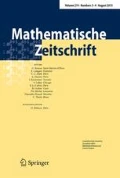Abstract
Let \({\mathbb {F}}\) be a non-archimedean local field of characteristic different from 2. We consider distributions on \(\mathrm {GL}(n+1,{\mathbb {F}})\) which are invariant under the adjoint action of \(\mathrm {GL}(n,{\mathbb {F}})\). We prove that any such distribution is invariant under transposition. This implies that the restriction to \(\mathrm {GL}(n,{{\mathbb {F}}})\) of any irreducible smooth representation of \(\mathrm {GL}(n+1,{{\mathbb {F}}})\) is multiplicity free. The characteristic zero case was proven in [5], and we use many ideas of that proof.
Similar content being viewed by others
References
Aizenbud, A., Avni, N., Gourevitch, D.: Spherical pairs over close local fields. Commentarii Mathematici Helvetici 87(4), 929–962 (2012)
Aizenbud, A., Gourevitch, D.: A proof of the multiplicity one conjecture for \(\text{GL}_n\) in \(\text{ GL}_{n+1}\), arXiv:0707.2363v2 [math.RT]
Aizenbud, A., Gourevitch, D.: Multiplicity one theorem for \(({\text{ GL }}_{n+1}({\mathbb{R}}),{\text{ GL }}_n({\mathbb{R}}))\). Sel. Math. New Ser. 15, 271–294 (2009). See also https://doi.org/10.1007/s00029-009-0544-7
Aizenbud, A., Gourevitch, D.: Multiplicity Free Jacquet Modules. Canadian Mathematical Bulletin 55(4), 673–688 (2012)
Aizenbud, A., Gourevitch, D., Rallis, S., Schiffmann, G.: Multiplicity one Theorems. Annals of Mathematics 172(2), 1407–1434 (2010). See also arXiv:0709.4215 [math.RT]
Aizenbud, A., Gourevitch, D., Sayag, E.: (GLn+1(F);GLn(F)) is a Gelfand pair for any local field F, post-print: arXiv:0709.1273v4 [math.RT]. Originally published in: Compositio Mathematica, 144 , pp 1504-1524 (2008)
Bernstein, J.: \(P\)-invariant Distributions on \(\text{ GL }(N)\) and the classification of unitary representations of \(\text{ GL }(N)\) (non-archimedean case) Lie group representations, II (College Park, Md., 1982/1983), 50–102, Lecture Notes in Math., 1041, Springer, Berlin (1984)
Bernstein, J., Zelevinsky, A.V.: Representations of the group \(\text{ GL }(n, F)\), where F is a local non-Archimedean field. Uspekhi Mat. Nauk 10(3), 5–70 (1976)
Gantmakher, F.R.: The theory of matrices (1959)
Gan, W.T., Gross B.H., Prasad, D., Waldspurger, J.-L.: Sur les conjectures de Gross et Prasad. I. (French) [On the conjectures of Gross and Prasad. I] Astérisque No. 346 (2012). Société Mathématique de France, Paris, 2012. xi+318 pp
Gelfand, I.M., Kajdan, D.A. [Kazhdan]: Representations of the group GL(n,K) where K is a local field. Lie Groups and Their Representations (Budapest, 1971), Halsted, New York, 1975, 95 - 118. MR 0404534
Rallis, S., Schiffmann, G.: Multiplicity one Conjectures, arXiv:0705.2168v1 [math.RT]
Sun, B., Zhu, C.-B.: Multiplicity one theorems: the Archimedean case. Annals of Mathematics (2) 175(1), 23–44 (2012)
Vrabel, R.: A note on the Matrix Determinant Lemma. International Journal of Pure and Applied Mathematics 111(4), 643–646 (2012)
Acknowledgements
I would like to deeply thank my advisor, Dmitry Gourevitch, for guiding me through this project, for exposing me to this fascinating area of mathematics, and for teaching me the required background in mathematics. I would also like to thank him for the exceptional availability and willingness to help throughout the process. The starting point of this work was a discussion between my advisor and Guy Henniart in Summer 2017, and so I deeply thank Guy Henniart for sharing his work on this problem with us. I would also like to thank Avraham Aizenbud for his help along the way. I want to thank my friends with whom I have discussed this work and who have given me helpful feedback, among which are Nitzan Tur, Shachar Carmeli, Guy Kapon, and Guy Shtotland. In addition, I would like to thank Lev Radzivilovsky, Shachar Carmeli, and Guy Kapon for teaching me a huge amount of mathematics in the past and in the present. I am grateful to the anonymous referee and to the editor Dipendra Prasad for their useful remarks and suggestions. D.M. was partially supported by ERC StG grant 637912.
Author information
Authors and Affiliations
Corresponding author
Additional information
Publisher's Note
Springer Nature remains neutral with regard to jurisdictional claims in published maps and institutional affiliations.
Appendix A. Lemmas in linear algebra
Appendix A. Lemmas in linear algebra
Our aim in this appendix is to prove Theorem 4.7. In all of the following discussion, V may be a finite dimensional vector space over any field \({{\mathbb {F}}}\), and we assume we have \(A\in \mathrm {gl}(V)\), \(v\in V\), and \(\phi \in V^*\).
Notation A.1
Let \(B\in \mathrm {gl}(V)\). We denote the characteristic polynomial of B by
Theorem A.2
For any \(1\le k\le n\),
With this theorem, we can prove the desired Theorem 4.7 easily.
Proof of Theorem 4.7
By replacing v with \(\lambda v\) we get
Now \((1)\Rightarrow (2)\) is a direct consequence. As this formula is linear in \(\lambda \), one gets \((2)\iff (3)\iff (4)\). For \((3)\Rightarrow (1)\), use induction on k to show \(\phi A^k v=0\) for all \(k\ge 0\). If the claim is true for all non-negative integers smaller than k (it might be that \(k=0\) and so this condition is trivial), then
hence the claim. \(\square \)
1.1 A.1 Proof of Theorem A.2
Recall that for any element \(A\in \mathrm {gl}(V)\), one defines \(\mathrm {adj}(A):=(-1)^{n+1}\sum _{k=0}^{n-1} {c_k(A) A^{n-k-1}}\). It is characterized by \(\mathrm {adj}(A)A=A\mathrm {adj}(A)=\det (A)I\).
Lemma A.3
(Matrix Determinant Lemma, see [14, Theorem 2 for k=1]).
Notation A.4
Let p(x) be a polynomial. We denote
Direct computation shows that if \(p(x)=\sum _{i=0}^n a_i x^i\) then
In particular, \(\Delta _p(x,y)\) is a polynomial in x, y.
Proposition A.5
( [9, p. 85]). We have \(\mathrm {adj}(\lambda I-A)=\Delta _{P_A}(\lambda I, A)\).
Proof
Since both sides are polynomials in \(\lambda \) and A, it is enough to check for a Zariski open subset. If \(\lambda I-A\) is invertible then
thus equation follows for all \(\lambda ,A\). \(\square \)
Proof of Theorem A.2
Applying Lemma A.3 to \(\lambda I-A\) (and to \(-v\) instead of v), we get
Substituting Proposition A.5, we get
Isolating the coefficients of \(\lambda ^i\) we get the equation in Theorem A.2. \(\square \)
Rights and permissions
About this article
Cite this article
Mezer, D. Multiplicity one theorem for \((\mathrm {GL}_{n+1},\mathrm {GL}_n)\) over a local field of positive characteristic. Math. Z. 297, 1383–1396 (2021). https://doi.org/10.1007/s00209-020-02561-1
Received:
Accepted:
Published:
Issue Date:
DOI: https://doi.org/10.1007/s00209-020-02561-1


